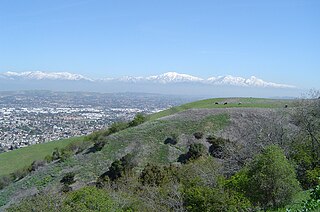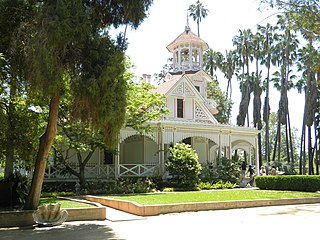
Mission San Gabriel Arcángel is a Californian mission and historic landmark in San Gabriel, California. It was founded by the Spanish Empire on "The Feast of the Birth of Mary," September 8, 1771, as the fourth of what would become twenty-one Spanish missions in California. San Gabriel Arcángel was named after the Archangel Gabriel and often referred to as the "Godmother of the Pueblo of Los Angeles."

The Tongva are an Indigenous people of California from the Los Angeles Basin and the Southern Channel Islands, an area covering approximately 4,000 square miles (10,000 km2). In the precolonial era, the people lived in as many as 100 villages and primarily identified by their village rather than by a pan-tribal name. During colonization, the Spanish referred to these people as Gabrieleño and Fernandeño, names derived from the Spanish missions built on their land: Mission San Gabriel Arcángel and Mission San Fernando Rey de España. Tongva is the most widely circulated endonym among the people, used by Narcisa Higuera in 1905 to refer to inhabitants in the vicinity of Mission San Gabriel. Some people who identify as direct lineal descendants of the people advocate the use of their ancestral name Kizh as an endonym.

Arcadia is a city in Los Angeles County, California, United States, located about 13 miles (21 km) northeast of downtown Los Angeles in the San Gabriel Valley and at the base of the San Gabriel Mountains. It contains a series of adjacent parks consisting of the Santa Anita Park racetrack, the Los Angeles County Arboretum and Botanic Garden, and Arcadia County Park. The city had a population of 56,364 at the 2010 census, up from 53,248 at the 2000 census. The city is named after Arcadia, Greece.

The San Gabriel Valley, often referred to by its initials as SGV, is one of the principal valleys of Southern California, with the city of Los Angeles directly bordering it to the west, and occupying the vast majority of the southeastern part of Los Angeles County. Surrounding landforms and other features include the following:

Colorado Boulevard is a major east–west street in Southern California. It runs from Griffith Park in Los Angeles east through Glendale, the Eagle Rock section of Los Angeles, Pasadena, and Arcadia, ending in Monrovia. The full route was once various state highways but is now locally maintained in favor of the parallel Ventura Freeway and Foothill Freeway (I-210).

Hugo Reid, a Scottish immigrant, was an early resident of Los Angeles County who became known for writing a series of newspaper articles, or "letters," that described the culture, language, and contemporary circumstances of the local Tongva (Gabrieleño) people. He criticized the Franciscan missionaries, who administered the Spanish missions in California, for their treatment of the native peoples.

Benjamin Davis Wilson, commonly known as Don Benito Wilson, was an American-Mexican politician, fur trapper, and ranchero of California. Born in Tennessee, Wilson eventually settled in Alta California when it was part of the Republic of Mexico, and acquired Rancho Jurupa. He became a naturalized Mexican citizen and married into a prominent Californio family.

The Los Angeles County Arboretum and Botanic Garden, 127 acres, is an arboretum, botanical garden, and historical site nestled into hills near the San Gabriel Mountains in Arcadia, California, United States. Open daily, it only closes on Christmas Day.

Located in Los Angeles County, California's San Gabriel Valley, the Boy Scouts of America's San Gabriel Valley Council (#40) was one of five councils serving Los Angeles County. It was headquartered in Pasadena.
The Hahamog'na, commonly anglicized to Hahamongna and spelled Xaxaamonga in their native language, are a tribe of the Tongva people of California. Their language belongs to the Uto-Aztecan family.

Elias Jackson "Lucky" Baldwin was "one of the greatest pioneers" of California business, an investor, and real estate speculator during the second half of the 19th century. He earned the nickname "Lucky" Baldwin due to his extraordinary good fortune in a number of business deals. He built the luxury Baldwin Hotel and Theatre in San Francisco and bought vast tracts of land in Southern California, where a number of places and neighborhoods are named after him.
Rancho Santa Anita was a 13,319-acre (53.90 km2) land grant in present-day Los Angeles County, California given to naturalized Scottish immigrant Hugo Reid and his Kizh people wife. Reid built an adobe residence there in 1839, and the land grant was formally recognized by Governor Pio Pico in 1845. The land grant covered all or portions of the present day cities of Arcadia, Monrovia, Sierra Madre, Pasadena and San Marino. A small portion of the rancho has been preserved as the Los Angeles County Arboretum and Botanic Garden.

Queen Anne Cottage and Coach Barn is a Victorian style pair of buildings at Baldwin Lake, on the grounds of the Los Angeles County Arboretum and Botanic Garden, located in Arcadia and the San Gabriel Valley of southern California.
Alyeupkigna is a former Tongva-Gabrieleño Native American settlement in Los Angeles County, California.
Rancho Huerta de Cuati was a 127-acre (0.51 km2) Mexican land grant in the San Rafael Hills area of present-day Los Angeles County, California given in 1838 by governor Juan Alvarado to Victoria Reid. The name means "Cuati Garden" in Spanish. The rancho included present-day Alhambra, San Marino, South Pasadena, and Pasadena—and Lake Wilson.

Arcadia station is an at-grade light rail station on the A Line of the Los Angeles Metro Rail system. It is located at the intersection of 1st Avenue and Santa Clara Street in Arcadia, California, after which the station is named.

A Dawn In The West is the title of a 2013 bronze statue by Alfred Paredes of Elias J. “Lucky” Baldwin (1828–1909), pioneer California rancher, businessman founder and first mayor of Arcadia. Commissioned and donated to the City of Arcadia by Baldwin's great, great, great granddaughters, Margaux Gibson-Viera and Heather Gibson, both of California, the 9-foot bronze figure of Baldwin stands on a 4-foot concrete plinth in the center of the Monsignor Gerald M. O’Keefe Rose Garden, at the intersection of Huntington Drive and Holly Avenue, in Arcadia, California. It was dedicated on April 16, 2013.
Kizh Kit’c are the Mission Indians of San Gabriel, according to Andrew Salas, Smithsonian Institution, Congress, the Catholic Church, the San Gabriel Mission, and other Indigenous communities.

The Reid-Baldwin Adobe, formerly called the Hugo Reid Adobe, is an adobe house built in 1839. It is located at the Los Angeles County Arboretum and Botanic Garden in Arcadia, California. The Hugo Reid Adobe was designated a California Historic Landmark on April 3, 1940. The Reid Adobe was built by Scottish−Mexican Hugo Reid on the shore of what is now called Baldwin Lake, with the help of local natives. Reid received the full Mexican land grant for Rancho Santa Anita in 1845, which included 13,319 acres of land. Reid farmed some of the land and planted grape vines.



















